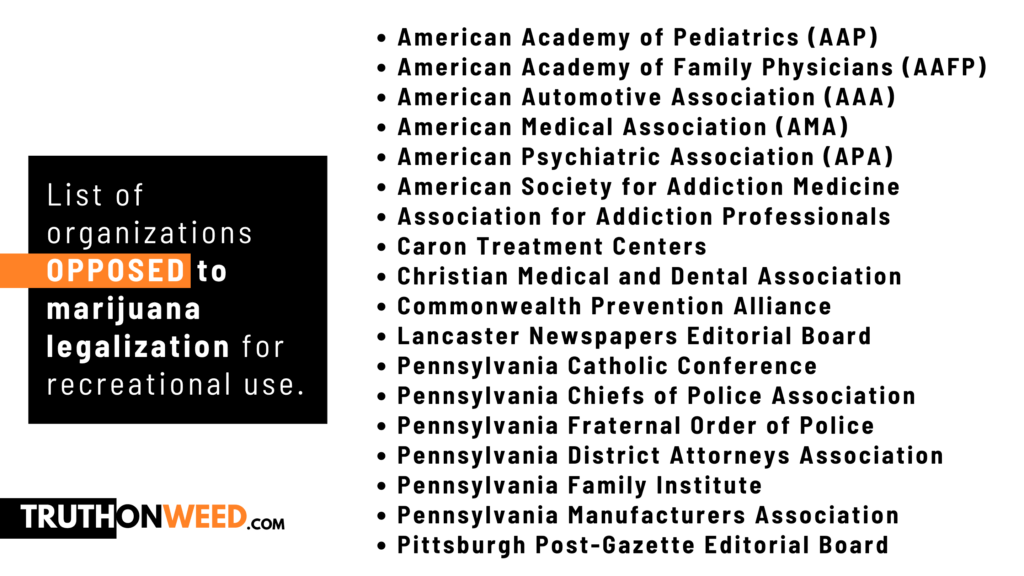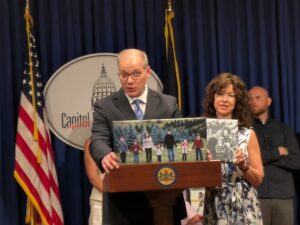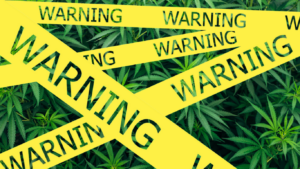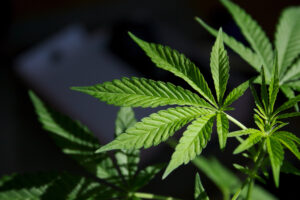Today’s marijuana products — including high-potency vapes, edibles, dabs, and extracts — are far stronger and more dangerous than ever before. Legalizing the commercial sale of these products for recreational use would harm Pennsylvania families and communities.
“There is substantial evidence that marijuana use is contributing to rising addiction rates and other serious harms, and commercializing its sale will make these issues worse.”
– An open letter to Gov. Shapiro signed by over 160 pastors and church leaders in Pennsylvania, including Dr. Todd Williams (President and CEO of Cairn University), Dr. Barry Whitworth (Baptist Resource Center), and Dr. Don Immel (PennDel Assemblies of God).
The evidence from states that have experimented with legalization is clear: marijuana causes harm, it can cause addiction, and legalization for recreational sale would worsen public health and safety in Pennsylvania.
Here’s a summary of the evidence in 12 reasons to reject state marijuana legalization for non-medical (recreational) purposes:
1. Parents speaking out.
Watch today’s press conference with parents sharing their story of how their family is broken as a result of their child’s marijuana use and how commercialization will make it worse. Click here to watch.
2. No local referendum and an unreasonable opt-out process for retail pot shops (“cannabis stores”).
This is the heavy hand of government that is virtually forcing every municipality to allow a retail dispensary for recreational sales of marijuana in their community, without regard for the desires of local residents and business owners.
HB1200 not only would allow for on-site consumption locations but for retail dispensaries there is an incredibly limited and difficult opt-out process: According to the proposed bill, upon determination of a marijuana retail location, it must be advertised in one newspaper and posted in a conspicuous place on-site. This then starts the clock on just FIVE DAYS for 100 taxpayers who live within a quarter mile of that location to petition a judge “because of its proximity to a church, school or to private residences.” No other reason for opposition is expressly allowed. And whatever the judge rules is final and cannot be appealed.
This process will burden local communities and is not in the best interests of the people of Pennsylvania.
3. Another Big Tobacco.
The marijuana industry has evolved into a new form of Big Tobacco, dominated by large corporations pushing ever-stronger THC products and maximizing profits while targeting young users for addiction.
- “In the 1980s, the average content of THC, the psychoactive ingredient in marijuana, was around 3%. The THC content in today’s commercial cannabis averages between 15 and 30% — with some products touting THC concentrations as high as 90%. This staggering increase in potency is directly associated with a variety of bad outcomes, including both short- and long-term marijuana-induced psychosis.” Stephen Catanzarite, charter school founder and nonprofit administrator
- “We went from having products that, on average, were 4 to 8% THC for blunts in Colorado now to 25%. Concentrates that used to be between 30 and 40% are now routinely 95% THC. That’s a huge difference in terms of what youth have access to.” Dr. Jesse Hinckley, assistant professor at the University of Colorado School of Medicine
- “The increasing potency, the new ways it can be used and the growing domination of the market by corporations, has complicated the question of legalization.” Pittsburgh Post Gazette Editorial Board
4. Youth-use increases.
More teens and young adults are using marijuana in legalized states, including concentrates, edibles, and extracts.
- A study by Temple University found that marijuana legalization for recreational use “is associated with risk factors for cannabis use disorder (CUD), including easier access to cannabis, stronger cannabis potency, greater variety of cannabis products, and exposure to cannabis advertising and sales.”
- “We can reasonably expect that, with its legalization, the prevalence of marijuana use among both adults and adolescents will increase in our state…heavy use results in higher rates of mental health conditions such as anxiety, and psychosis. ” Dr. Sheryl Ryan, Member, PA Chapter, American Academy of Pediatrics
- “Since the legalization of marijuana, our District has observed a distressing escalation in drug-related infractions.” Dr. Nikolai Vitti, Superintendent, Detroit Public Schools Community District. For Michigan’s largest public school district, from 2019 to 2021, there were 289 drug-related incidents. Between 2021 and 2023, the number surged to 1,735. From January to April 2024, the number was already 745.
- “Some teens are getting their hands on marijuana already. But why make it easier for them?” LNP Editorial Board
5. More mental health problems.
Marijuana is linked with mental health issues like psychosis and schizophrenia, along with “depression, social anxiety; and thoughts of suicide, suicide attempts, and suicide.” (CDC)
- “The marijuana industry sold the American people a lie. Any honest assessment of the evidence reveals that, contrary to the narratives pitched by supporters, marijuana is really awful for mental health…Scientific studies have long shown that marijuana use is associated with increases in mental health disorders like schizophrenia and depression all over the world, including the United States, Sweden, the Netherlands, Australia, and New Zealand.” – Dr. Luke Conway, professor of psychology at Grove City College
- “At Caron, where patients who experienced THC-induced psychosis was once rare, it is now common among patients being referred.” – Kate Appleman, Executive Vice President of PA Clinical Programs at Caron Treatment Centers
- “Marijuana can cause paranoia or psychosis, but also with long-term and regular use it can lead to worsening levels of anxiety and depression.” Dr. Eric Hussar, Pennsylvania State Director, American Academy of Medical Ethics
- “Mental health issues continue to increase at an alarming rate, impacting the overall behavioral health of youth and young adults. Prevention organizations, coalitions, and professionals are attempting to effectively prevent and address these issues with youth, young adults, and adults in their community. Legalizing and introducing recreational marijuana are counterintuitive to the health and safety of PA communities.” Jeff Hanley, Commonwealth Prevention Alliance
6. More children in the ER.
Liberal marijuana laws have led to more children exposed to marijuana and more strains on health care systems.
- From 2019 to 2022, the number of emergency room visits for children 10 and under involving THC tripled. (CDC)
- “In Colorado, hospitalization rates involving possible marijuana exposures, diagnoses or billing codes more than quadrupled after the legalization of commercial sales. Marijuana-related emergency department and urgent care visits for teenagers and young adults have increased since legalization, and the majority require behavioral health evaluation.” Luke Niforatos, Vice President for Policy, Smart Approaches to Marijuana
- “Every single day, we are getting a call from Pennsylvania and Delaware about a child under the age of six who has become exposed or injured in some way by THC products.” Dr. Kevin Osterhoudt, medical director of The Poison Control Center at Children’s Hospital of Philadelphia (CHOP)
7. More addictive use.
More people now use marijuana regularly than regularly consume alcohol.
- Marijuana “is an addictive drug.” American Addiction Centers
- “The enormous changes in rates of self-reported cannabis use, particularly of daily or near-daily use, suggest that changes in actual use have been considerable. It is striking that high-frequency cannabis use is now more commonly reported than is high-frequency drinking.” Jonathan P. Caulkins, professor of operations research and public policy at Carnegie Mellon’s Heinz College
- “In order to reach the tax goals that Governor Shapiro hopes to achieve, Pennsylvania’s legal apparatus would need to sell over 25.5 million eighths of pot per year. (An “eighth” is an eighth of an ounce, which produces several joints.) To put that in perspective, the ten million Pennsylvanians over 21 would need to smoke more than 250 million joints per year to reach those levels of revenue. The idea that every college student, their parents, and their grandparents will all light up twice a month is absurd, of course. What will happen is that half will not consume any marijuana at all, and 10%, or one million Pennsylvanians, will become daily habitual users…That small minority is the group the governor will make his revenue targets on. Is it right to help fix the state’s budget by exploiting one group?” Chris McGuinn, founder of More Than 28
8. More car accidents and fatalities.
AAA opposes the legalization of marijuana for recreational use because of its inherent traffic safety risks.
- “Given the statistics that are available today, it is clear and indisputable that the use of recreational marijuana negatively impacts the motoring, pedestrian, and special needs community and that innocent people in states where the recreational use of marijuana has been legalized are at a greater risk of harm, injury, and death due to the increased numbers of drug-impaired drivers.” – Scott Bohn, executive director for the PA Chiefs of Police Association
- “Marijuana is a dangerous drug that poses a real threat to public safety and public health.” Pennsylvania Fraternal Order of Police
- “One in three DUIs issued by Colorado law enforcement in 2020 identified marijuana as an impairing substance. Sadly, the consequences of driving while high also fall on nonusers who are injured—or killed—by impaired drivers.” Bill Barr, former U.S. Attorney General
9. Black market continues.
Sales on the illicit market are still booming in states experimenting with legalization.
- “Far from eliminating the black market, legalization has facilitated its proliferation. The market for illicit marijuana is seven times as large as the demand in the legal market.” Bill Barr, former U.S. Attorney General
- “Based on the experience of other states, we know that law enforcement resources, as well as public health and other governmental services, will be taxed with new call volume due to the nature of marijuana impairment and its relationship to criminality, including victimization, and mental health.” Florida Police Chiefs Association president Chief Charles Vazquez
- Oregon has spent $46 million fighting black market cannabis. Officials can’t tell if it’s working. “It is not possible to draw conclusions about whether the grant has reduced Oregon’s illegal marijuana market at this time.” Oregon Public Broadcasting
10. Social justice woes.
You cannot achieve real criminal justice reform through commercializing harmful drugs.
- “How does adding more drug locations – whether state-run or privately owned, Black-owned or white-owned – help rebuild families shattered by addiction? The color of the business owner doesn’t change the harm the product causes.” Judge Cheryl Allen, of counsel for Pennsylvania Family Institute
- “The marijuana industry has always been inundated with influence from big tobacco, another industry that has already proven itself to target minorities and ignore public health costs in their push for profit.” Luke Niforatos, Executive Vice President for Smart Approaches to Marijuana
- “The full legalization and commercialization of marijuana would spawn Big Tobacco 2.0—and, because of today’s highly intoxicating THC levels, would result in far worse consequences for social justice within at-risk communities.” Will Jones, Smart Approaches to Marijuana
11. Workplace safety jeopardized.
Marijuana positivity rates in the workplace are at an all-time high.
- “If you can’t pass the drug test, we can’t have you on the plant floor. My nightmare scenario is the Commonwealth working against workforce development and workplace safety.” – David Taylor, executive director for the Pennsylvania Manufacturers Association
- “Lost amid the legalization hullabaloo is the chaos unfettered pot will wreak on labor practices, workplace litigation, employer liability, health care costs and more…Before jumping on the pot bandwagon, lawmakers should count the costs of legalization — and conclude the price tag on Pennsylvania is simply too high.” Rob Shearer
- Quest Diagnostics found that marijuana positivity for drug tests increased 2.5 times in states where marijuana was legalized for non-medical sales. “Increases in positivity rates for marijuana in the general U.S. workforce were most striking in states that have enacted recreational use statutes since 2016.”
12. Inflated revenue projections
Marijuana accounts for less than 1% of state budgets in states that have legalized it, and no state has made the money that advocates project. For example, in New York, marijuana tax revenues and fees amount to less than one-tenth of one percent of the state’s budget.
- “For Pennsylvania, any short-term revenue increase will be swallowed up by the serious long-term social and economic effects of legalization.” Dr. Tom Copeland, former director of research, Centennial Institute
- “Commercializing marijuana is an overwhelmingly negative policy change for youth drug use rates. In general, effective drug policy discourages drug use – commercializing marijuana does exactly the opposite, creating an industry that is financially incentivized to addict as many new users as possible.” Dr. Aaron Weiner, psychologist
- “The cost to society of recreational marijuana legalization is greater than tax revenues produced from its sales.” Christian Medical and Dental Association

Today’s Marijuana:
It’s causing harm. It can cause addiction.
State legalization will make it worse.
Take Action: Contact your State Representative and State Senator to oppose marijuana legalization for recreational use. Click here to send an email.





